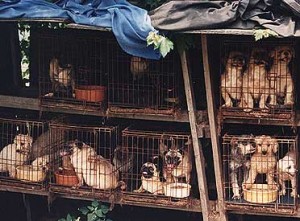The Awful Reality of Puppy Mills
June 1, 2009 by LaBecs
Filed under The Awful Reality of Puppy Mills
You’ve probably heard about puppy mills. But did you know that if you purchase a dog from a pet store and many of the breeders online or in the newspaper, you could be helping keep the puppy mill industry afloat?
Most people don’t realize where those dogs who suffer so much end up. They often don’t even know how much suffering the dogs have to endure. Below is some information you should read before you decide how to find your new canine companion.
The Abuses of Puppy Mills
If you’re not familiar with the term “puppy mill”, you may want to learn about them before you start looking around for your new puppy or dog. Basically, puppy mills operate like factories to produce new offspring that can be sold.
Female dogs are bred from their first heat cycle and again each time until they are no long able to reproduce. Then they are “disposed of.” The puppies are kept with their mothers in tiny cages, usually stacked on top of one another in cramped and dirty environments. Because the cages are made from wire, the excrement and urine from the above dogs can fall down onto the lower dogs. The wire cages also cause foot injuries and are very uncomfortable.

A Living Hell
Most of the dogs are underfed. Most have worms because of their close quarters and their unhygienic environment. Fleas and mites are huge problems because most of these puppy mills are located in the country and none of them receive any type of preventative care. Some even contract heart worms and other serious illnesses. They also tend to have emotional problems because they lack any human contact during their formative years, and because their mothers are usually too weak to give them much compassion.
In some of the worst of these places, dead dogs are left in the cages to decompose with the living ones.
Where the Puppies Go
As you can imagine, most “hell operators”, as I like to call them, do not sell their “stock” from their factory. Instead, they have other ways of connecting with potential customers. Pet shops are one of the largest buyers. Most of the dogs you see being sold in pet stores for hundreds of dollars were bought for a fraction of that from puppy mills. However, since the puppy mills sell hundreds of dogs every couple of months, they are profiting from these sales in major ways.
But pet stores are only one method. Many of the breeders who advertise online and in the newspaper are also puppy mills themselves or are selling supplies of dogs they have gotten from puppy mills.
What you get is a puppy facing an array of immediate medical problems and with genetic diseases that will surface years later.
Signs of a Puppy Mill
Regardless of what pet stores may say, their supply of dogs comes from puppy mills. However, with breeders, you may have a harder time recognizing the possibilities. To protect yourself, always ask to visit the puppies on-site so you can view the condition of the mother and possibly the father. For obvious reasons, if you are buying directly from a puppy mill, they will have some excuse as to why you cannot do this.
If you do arrive on-site but are not allowed to see the mother of the puppies, this is also a sign the puppies may be from a puppy mill and that the mother may be another location altogether.
Never buy a puppy without seeing where they and their parents are raised and housed with your own eyes. Do your research; get references about breeders in your area.
While your heart may go out to these suffering puppies, when you buy them from these sources you’re only contributing to the problem and continuing the puppy mill business. That’s why I always urge and encourage people to adopt either from a humane society, a rescue, or a shelter, and help put those torture chambers out of business for good.

